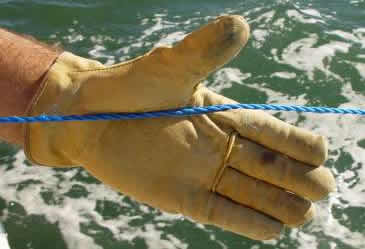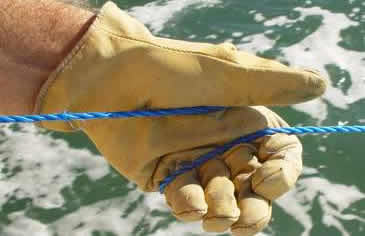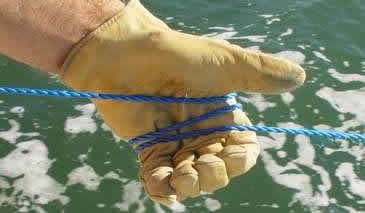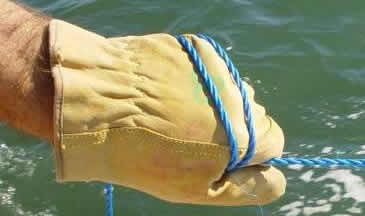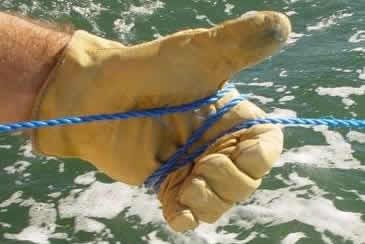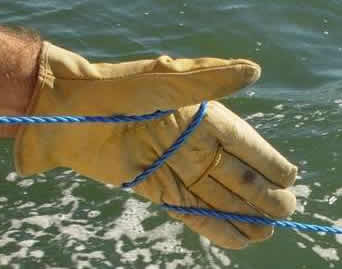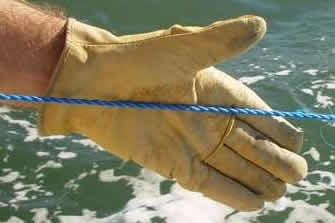04: Taking the Wrap
Between The Lines - Ch 08: Training
|
The main tools for taking the trace are gloves. Throughout the practice runs try various types of gloves as well as combinations such as leather over cotton or silicon over leather. Also try gloves on the thin leader and thick to see how well they grip and if nylon leader slips under load, a lot of load. Try all gloves wet and dry as their ability to grip may change. As important as knowing how to take wraps, is knowing how to drop, or dump them is the most important. A brief guide to the motions in taking wraps is as follows: Firstly brace yourself against the gunwale, squat down slightly with knees bent as if whatever is on the other end is going to try and rip you over the side of the boat.
|
||||||||||||||||||
You can certainly take wraps with both hands. Get used to the distance between your hands which allows youto pull the inside hand out of the wrap using the other hand to pull against. Training to take wraps should be done through different levels from just learning the hand motions to taking the full strain of heavy moving objects. (vid 1) The single attribute that separates a master traceman from a novice is the ability to apply smooth pressure with no slack to the fish to keep it under control. It’s important to know what drag has been used on the fish to get it in position so that equal pressure can be applied to the trace. If the fish was brought in on 5kg drag and the pressure goes straight to 20kg the fish may react rather adversely.
Although we have concentrated on taking wraps, often just grabbing the line with gloved hands may be sufficient without taking wraps. It's a decision the leader man has to make (Vid 2)
Once a crewman is confident in their motions taking the trace, they will enjoy grabbing the leader as much as the angler likes working the rod. In most cases, everything will run smoothly but there is always an element of danger that you should be prepared for. Clothing should not be loose as it may get caught in flying loops if the trace is dumped. If in a worse case scenario, the traceman gets tangled up or loses balance and footing ending up over the side they should be wearing a life jacket, even if it's a self-inflating one, plus safety cutters designed to be worn on a cord around the neck tucked inside their shirt, or cutters on the belt in a position that can be reached by either hand. The crew should practice using cutters with both hands in case one or the other is tangled up. Certainly with a lot of experience a traceman can help win tournaments by getting the hooks to flex out quickly and easily once a fish has been tagged so you can get back fishing to maximise the bite time. In the clip, the traceman puts a bit of slack on the leader before jerking the leader which flexes light gauge hooks out of the fish's jaw. |






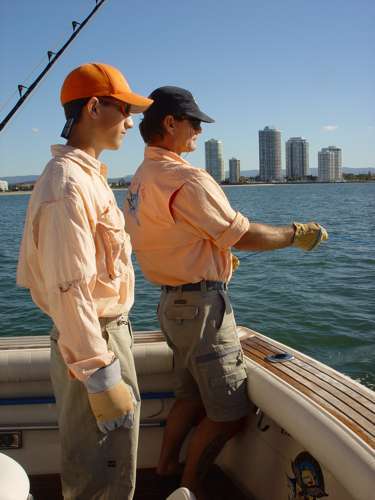 One of the most exciting parts of game and sportfishing is when the trace is finally in the hands of the crew. The angler has done their job getting the leader within reach with the help of the skipper’s boat handling. Those first few wraps are taken with care as the weight of the fish is felt. Will the fish react or come in easy? The fish can still go ballistic in a second. There are so many things that can happen at ‘tracing time’ - hooks pull, leader breaks, crimps pull, fish jumps in the boat, fish dives under the boat.
One of the most exciting parts of game and sportfishing is when the trace is finally in the hands of the crew. The angler has done their job getting the leader within reach with the help of the skipper’s boat handling. Those first few wraps are taken with care as the weight of the fish is felt. Will the fish react or come in easy? The fish can still go ballistic in a second. There are so many things that can happen at ‘tracing time’ - hooks pull, leader breaks, crimps pull, fish jumps in the boat, fish dives under the boat. As important as any other job on a fishing team the leader man, or traceman as he is sometimes called, needs to have an understanding of the job, of course by practising the movements until they are second nature. You may not have time to think when all hell is breaking loose at the other end of the leader.
As important as any other job on a fishing team the leader man, or traceman as he is sometimes called, needs to have an understanding of the job, of course by practising the movements until they are second nature. You may not have time to think when all hell is breaking loose at the other end of the leader.